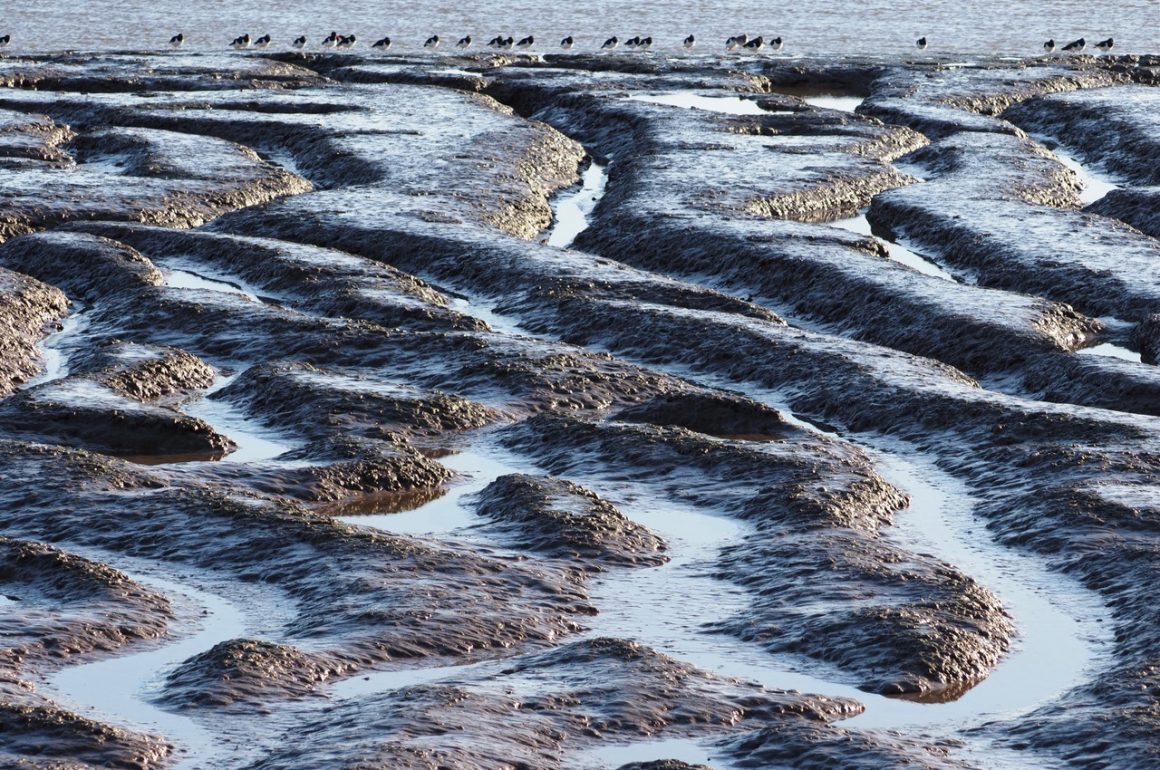
The weather forecast was grim, and the reality was even worse: New Year’s Day 2025 was horrible, starting with gale-force winds, then giving way, as the wind lost its venom, to steady, persistent rain. I was out, walking Emma my spaniel, at first light, before the rain started, but buffeted by the vicious wind. I had my binoculars with me, so was able to admire my first Marsh Harrier of 2025 as it flew up from its reedbed roost on my local fen. Sadly, there wasn’t much else to see, so by the time we’d returned for breakfast my list had barely reached double figures. The rain soon started, ensuring that there was little incentive to go out again and look for birds. My New Year’s Day bird list finished on a mere 17 species, most of which were seen in the garden. With 200 my target for the year, this was a modest start.
Exactly 36 years before, I had started my year in the South Atlantic. To be more specific, I was on Pebble Island in the West Falklands. My diary noted that New Year’s Day 1989 had dawned grey and windy, “so there was little incentive to get up, and it wasn’t until 5.45am that I ventured out”. By 8am I’d walked six miles and seen a modest 26 species, but there were some crackers among them, ranging from Black-necked Swan to Rufous-chested Dotterel. “It was a delight to see a flying flock of 20 Chilöe Wigeon” I wrote, “calling to each other with loud wheeos, almost like being on the marshes at home”. The weather wasn’t great: “there were some fleeting bursts of sunshine, once a shower of rain, and always the wind”.
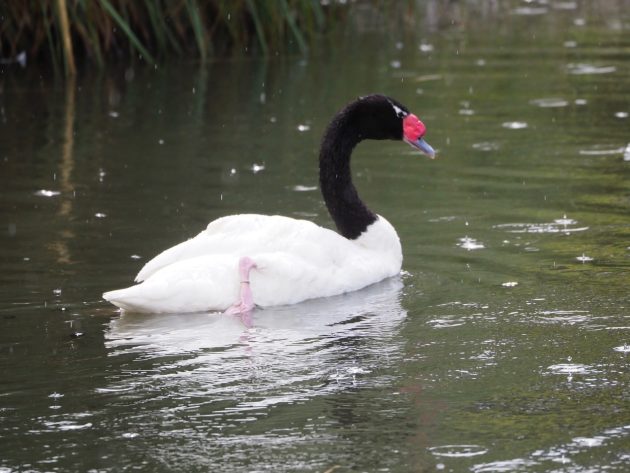
Black-necked Swan in the rain: one of my 39 species on a New Year’s Day count in the Falklands
Though I may have only seen a mere 26 species, I had seen a lot birds. “To the north there was a constant passage of Black-browed Albatrosses, hundreds of birds as far as the horizon, their white undersides catching the light as they sheared into the wind. There were many Giant Petrels, too, and on my walk back I stopped to watch two feasting on a dead Magellanic Penguin. It was rather like watching vultures on a kill, and the black and white penguin looked remarkably like a piece of zebra.”
I finished my listing that day at 6.30pm, by which time there wasn’t really much else to look for, though there was plenty of remaining light (sunset was after 9pm). My tally was a mere 39 species, but a pretty good score for a single day in the Falklands. I did see some live Magellanic Penguins, not just the dead one, but these were the only penguins of the day. A week before, on Christmas Day on Sea Lion Island, I’d seen five: King, Macaroni, Rockhopper, Gentoo and Magellanic. It’s worth going to the Falklands just for the penguins: all the other birds are a bonus.
Though my Falklands New Year’s Day list may have been modest, it was one of my most memorable starts to the year. This year was forgettable but fortunately the next two days – 2nd and 3rd of January – were bright and sunny, though very cold, giving me the incentive to go out and look for birds. On the 2nd I didn’t venture more than a few miles from home, but I pushed my 2025 list up to the half century mark, a total that included a couple of good birds: a Raven (a bird that is increasing in numbers here in Suffolk) and an unexpected Short-eared Owl. The latter was only my second local sighting in the 20 years I have lived in Suffolk.
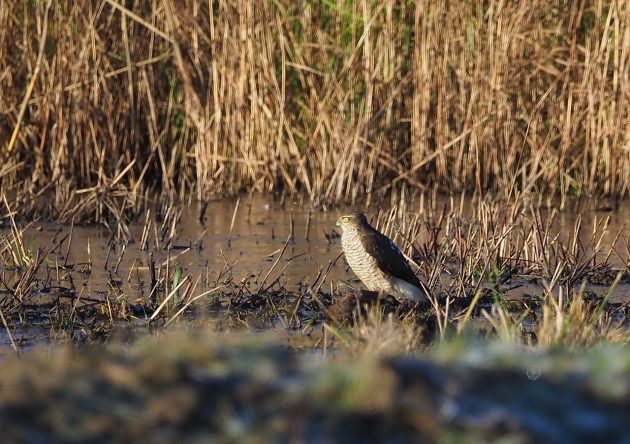
My first Sparrowhawk of the year, sitting on the edge of the marsh
The following day my birding pal Andrew and I made an early start for Frampton Marsh, an RSPB reserve in Lincolnshire, on the edge of the Wash. The latter is the largest natural bay in England, with numerous rivers draining into it. It is a vast area of extensive salt marshes, sand banks and mud flats, attracting internationally important numbers of wildfowl and waders.
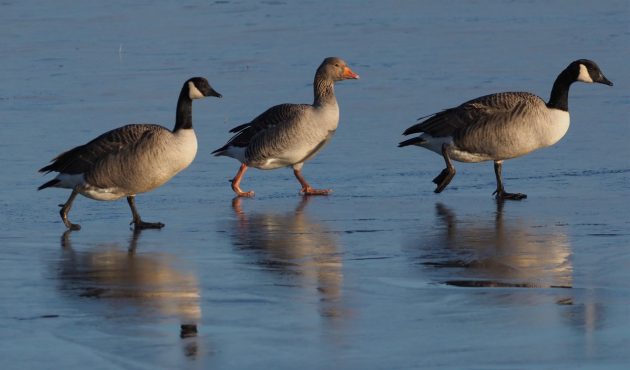
Geese on ice: two Canadas and a Greylag
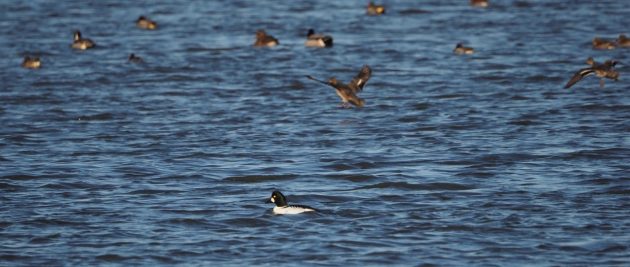
A fine drake Goldeneye
Frampton Marsh is freshwater, but borders the Wash, so our walk took us past the pools and lagoons created and managed by the RSPB, then on to the seawall and out to the Wash. Not surprisingly, my 2025 list soon started to grow. There was a rich variety of wildfowl to be admired, with Wigeon, Teal, Pintail, Shoveler, Gadwall and Teal all looking magnificent in the low winter sun. Several Goldeneyes were a bonus, while a party of Whooper Swans chose to fly right over us, a magnificent sight. The waders included all the expected species: Redshank, Ruff, Avocet, Black-tailed Godwit, Ringed Plover and Lapwing. When I went to investigate a male Sparrowhawk, sitting on the edge of the marsh, I flushed several Snipe.
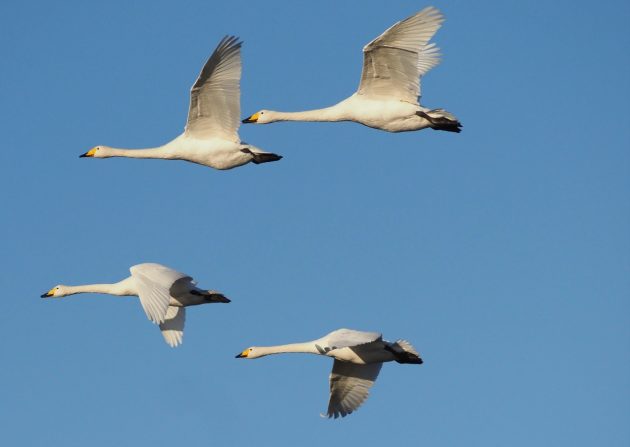
Whooper Swans
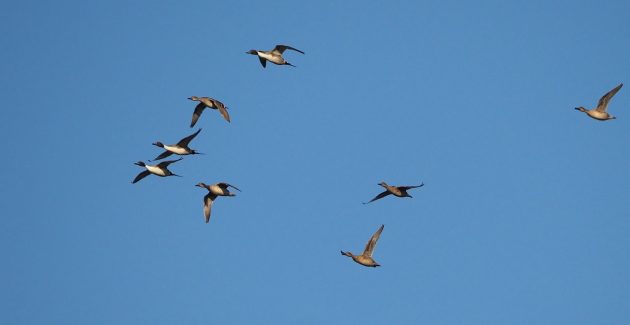
Pintail
It was a long trek before we were finally able to view the Wash itself, but it was a walk that was enlivened by flocks of Fieldfares, feasting on the hawthorn berries. It’s been a poor winter locally for Fieldfares, which are winter visitors to us from Scandinavia, so these were birds I enjoyed seeing.
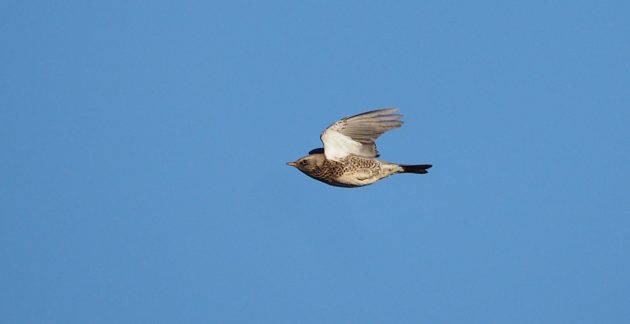
A passing Fieldfare
When we finally reached our destination, with the vast wilderness of the Wash stretching out before us, it was like reaching another world. There can be few places in England as wild, unspoilt and unvisited as this, so it was a treat to be able to sit and absorb the sounds and sights. Brent Geese were chuntering away, their guttural calls so evocative of the coast in winter, while the occasional Curlew called, its plaintive notes carrying far across the mudflats. Crowds of silent Oystercatchers were roosting close by – these are usually the noisiest of birds, but not when they are at rest. Work with the scope produced distant flocks of Knots (50,000 winter here), along with Dunlins, Redshanks and Bar-tailed Godwits.
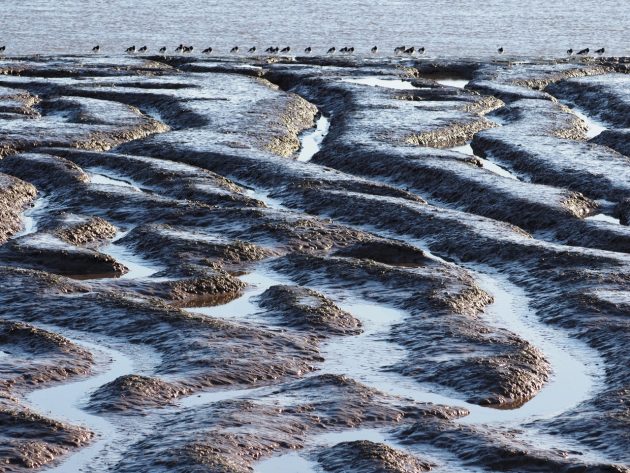
Look carefully and you will see Oystercatchers on the edge of the mud
There were ducks, too. Wigeon were the most numerous, but there were scores of Shelducks, and a couple of Red-breasted Mergansers. We looked in vain for the Eider and Slavonian Grebe that had been reported earlier, when the tide was high, but they were not to be seen.
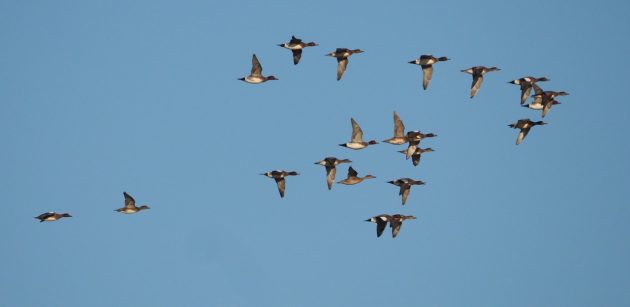
Wigeon
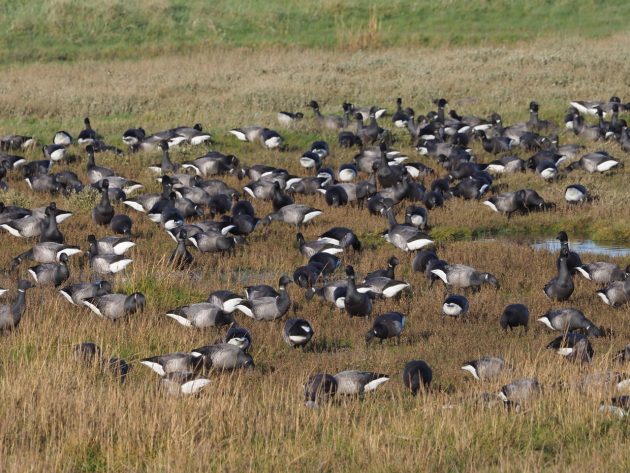
Dark-bellied Brent Geese
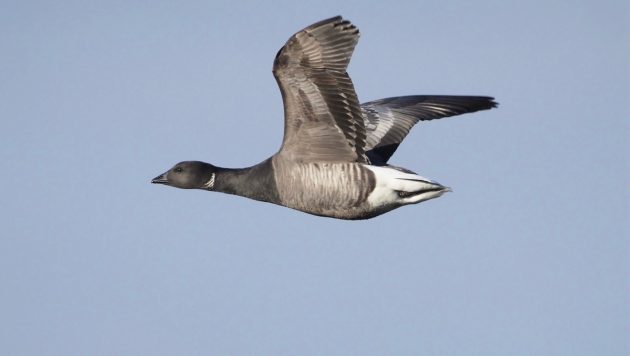
Brent Goose overhead. They are not a quarry species, so unlike most wild geese they are not wary
Dusk falls early at the start of January, and as the light started to fade hundreds of Golden Plovers flew into roost on the freshmarsh. The light had nearly gone when they all took off, looking like giant Starlings as they twisted, turned and soared overhead. It was only later, when I downloaded my photographs, that I saw they had been spooked by a male Hen Harrier, just visible in my photograph. This means that I have photographed a bird this year that I’m not aware of having seen. Hopefully my next coastal outing will produce a tickable Hen Harrier.
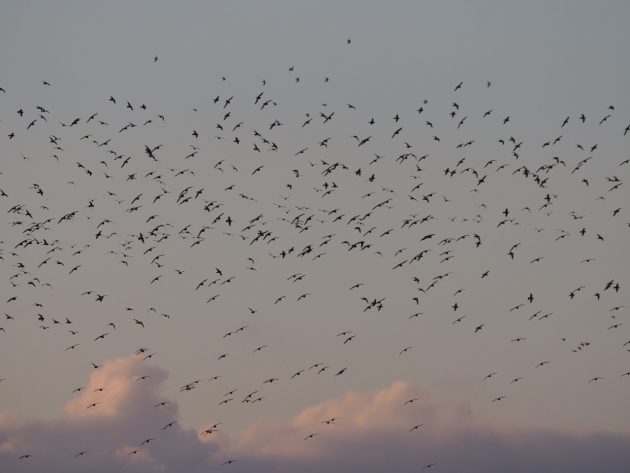
Golden Plovers at dusk, flushed by a Hen Harrier
Writing this, on 8 January, my year total has reached 89, the latest addition a Peregrine tiercel (male) that I watched catch a Starling this afternoon. (It was on a local farm where I was walking my spaniel). By the end of the week I hope to have topped the 100, as I have plans to visit the Suffolk coast on Friday. The next 100 will come much more slowly.
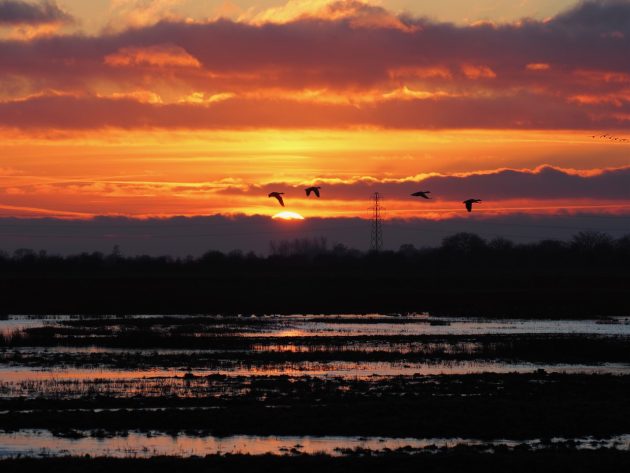






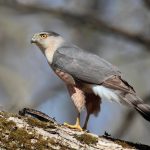
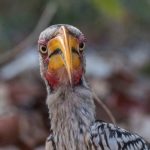
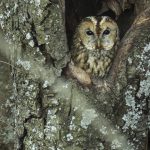
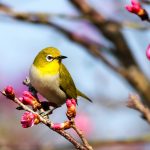


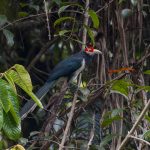
Looks like a great start of the year despite the climatological conditions.